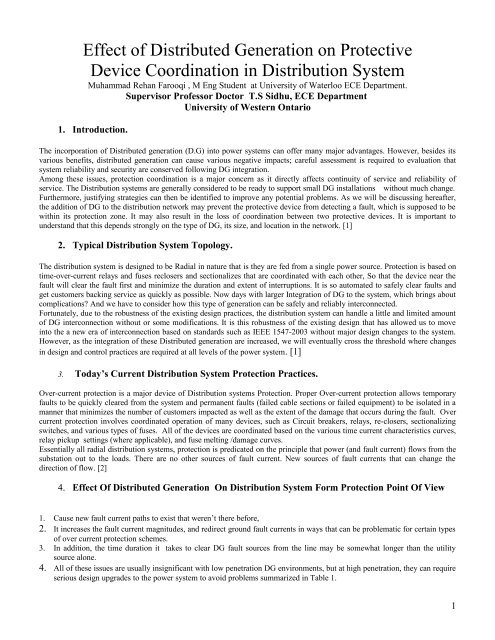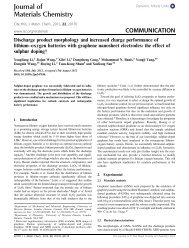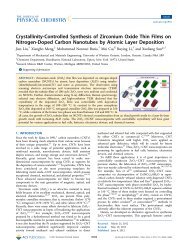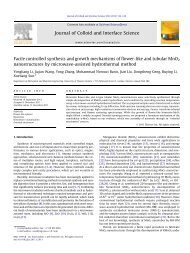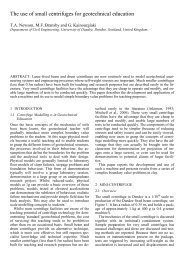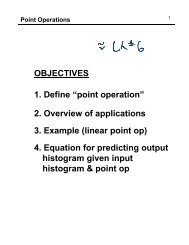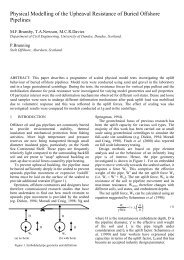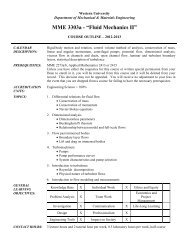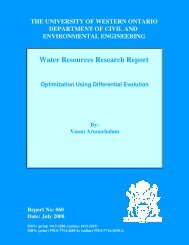(TMS) or Time Dial - Western Engineering - University of Western ...
(TMS) or Time Dial - Western Engineering - University of Western ...
(TMS) or Time Dial - Western Engineering - University of Western ...
You also want an ePaper? Increase the reach of your titles
YUMPU automatically turns print PDFs into web optimized ePapers that Google loves.
Effect <strong>of</strong> Distributed Generation on Protective<br />
Device Co<strong>or</strong>dination in Distribution System<br />
Muhammad Rehan Farooqi , M Eng Student at <strong>University</strong> <strong>of</strong> Waterloo ECE Department.<br />
Supervis<strong>or</strong> Pr<strong>of</strong>ess<strong>or</strong> Doct<strong>or</strong> T.S Sidhu, ECE Department<br />
<strong>University</strong> <strong>of</strong> <strong>Western</strong> Ontario<br />
1. Introduction.<br />
The inc<strong>or</strong>p<strong>or</strong>ation <strong>of</strong> Distributed generation (D.G) into power systems can <strong>of</strong>fer many maj<strong>or</strong> advantages. However, besides its<br />
various benefits, distributed generation can cause various negative impacts; careful assessment is required to evaluation that<br />
system reliability and security are conserved following DG integration.<br />
Among these issues, protection co<strong>or</strong>dination is a maj<strong>or</strong> concern as it directly affects continuity <strong>of</strong> service and reliability <strong>of</strong><br />
service. The Distribution systems are generally considered to be ready to supp<strong>or</strong>t small DG installations without much change.<br />
Furtherm<strong>or</strong>e, justifying strategies can then be identified to improve any potential problems. As we will be discussing hereafter,<br />
the addition <strong>of</strong> DG to the distribution netw<strong>or</strong>k may prevent the protective device from detecting a fault, which is supposed to be<br />
within its protection zone. It may also result in the loss <strong>of</strong> co<strong>or</strong>dination between two protective devices. It is imp<strong>or</strong>tant to<br />
understand that this depends strongly on the type <strong>of</strong> DG, its size, and location in the netw<strong>or</strong>k. [1]<br />
2. Typical Distribution System Topology.<br />
The distribution system is designed to be Radial in nature that is they are fed from a single power source. Protection is based on<br />
time-over-current relays and fuses reclosers and sectionalizes that are co<strong>or</strong>dinated with each other, So that the device near the<br />
fault will clear the fault first and minimize the duration and extent <strong>of</strong> interruptions. It is so automated to safely clear faults and<br />
get customers backing service as quickly as possible. Now days with larger Integration <strong>of</strong> DG to the system, which brings about<br />
complications? And we have to consider how this type <strong>of</strong> generation can be safely and reliably interconnected.<br />
F<strong>or</strong>tunately, due to the robustness <strong>of</strong> the existing design practices, the distribution system can handle a little and limited amount<br />
<strong>of</strong> DG interconnection without <strong>or</strong> some modifications. It is this robustness <strong>of</strong> the existing design that has allowed us to move<br />
into the a new era <strong>of</strong> interconnection based on standards such as IEEE 1547-2003 without maj<strong>or</strong> design changes to the system.<br />
However, as the integration <strong>of</strong> these Distributed generation are increased, we will eventually cross the threshold where changes<br />
in design and control practices are required at all levels <strong>of</strong> the power system. [1]<br />
3. Today’s Current Distribution System Protection Practices.<br />
Over-current protection is a maj<strong>or</strong> device <strong>of</strong> Distribution systems Protection. Proper Over-current protection allows temp<strong>or</strong>ary<br />
faults to be quickly cleared from the system and permanent faults (failed cable sections <strong>or</strong> failed equipment) to be isolated in a<br />
manner that minimizes the number <strong>of</strong> customers impacted as well as the extent <strong>of</strong> the damage that occurs during the fault. Over<br />
current protection involves co<strong>or</strong>dinated operation <strong>of</strong> many devices, such as Circuit breakers, relays, re-closers, sectionalizing<br />
switches, and various types <strong>of</strong> fuses. All <strong>of</strong> the devices are co<strong>or</strong>dinated based on the various time current characteristics curves,<br />
relay pickup settings (where applicable), and fuse melting /damage curves.<br />
Essentially all radial distribution systems, protection is predicated on the principle that power (and fault current) flows from the<br />
substation out to the loads. There are no other sources <strong>of</strong> fault current. New sources <strong>of</strong> fault currents that can change the<br />
direction <strong>of</strong> flow. [2]<br />
4. Effect Of Distributed Generation On Distribution System F<strong>or</strong>m Protection Point Of View<br />
1. Cause new fault current paths to exist that weren’t there bef<strong>or</strong>e,<br />
2. It increases the fault current magnitudes, and redirect ground fault currents in ways that can be problematic f<strong>or</strong> certain types<br />
<strong>of</strong> over current protection schemes.<br />
3. In addition, the time duration it takes to clear DG fault sources from the line may be somewhat longer than the utility<br />
source alone.<br />
4. All <strong>of</strong> these issues are usually insignificant with low penetration DG environments, but at high penetration, they can require<br />
serious design upgrades to the power system to avoid problems summarized in Table 1.<br />
1
Description <strong>of</strong> Fault Contribution<br />
Condition<br />
Increased Fault Current Magnitudes on the System Due to<br />
DG Fault Contributions<br />
Changes in Direction <strong>of</strong> Fault Current Flows <strong>or</strong> Additional<br />
New Flows not Present Bef<strong>or</strong>e Addition <strong>of</strong> DG<br />
Increased <strong>Time</strong> to Clear All <strong>of</strong> the Various DG<br />
Contributions Compared to Utility Source Alone<br />
5. Types <strong>of</strong> Fault Current contribut<strong>or</strong>s.<br />
5.1 Combustions Engine.<br />
Table 1<br />
Issues Related to Condition<br />
1. Can cause fault levels to exceed interrupting device rating.<br />
2. Can change fuse and circuit breaker co<strong>or</strong>dination parameters.<br />
3. Increased conduct<strong>or</strong> damage and/<strong>or</strong> distribution transf<strong>or</strong>mer tank rupture risk f<strong>or</strong> faults<br />
(due to higher magnitude).<br />
1. May cause sympathetic trip <strong>of</strong> reclosers <strong>or</strong> circuit breakers.<br />
2. Can desensitize ground fault relaying protection.<br />
3. Can cause netw<strong>or</strong>k protect<strong>or</strong>s to operate when they do not need to.<br />
4. Can confuse automatic sectionalizing switch schemes.<br />
1. Increased conduct<strong>or</strong> <strong>or</strong> equipment damage during fault (due to longer duration arcing <strong>or</strong><br />
current flow).<br />
2. Temp<strong>or</strong>ary faults may not be cleared as efficiently, defeating reclosing objective.<br />
This the w<strong>or</strong>st <strong>of</strong>fending distribution-Generation connected energy sources with regards to injected fault currents are rotating<br />
synchronous generat<strong>or</strong>s. These types inject m<strong>or</strong>e than twice as much fault current per unit <strong>of</strong> rated capacity as compared to the<br />
solid-state inverter devices. Internal combustion engines (ICE) and combustion turbines (CT), which usually use rotary are the<br />
largest fault current inject<strong>or</strong>s per unit <strong>of</strong> rated capacity.<br />
5.2 Converters.<br />
Inverter: Interfaced power sources such as PV, fuel cells, Wind Turbines and some Micro turbines are m<strong>or</strong>e justifying f<strong>or</strong>ms <strong>of</strong><br />
DG than their synchronous rotating generat<strong>or</strong> cousins. However, at high levels <strong>of</strong> distribution-connected DG penetration, even<br />
relatively benign inverter technology can still lead to problems.<br />
6. DG Hosting Capacity In Distribution With Respect To Protection System.<br />
In an existing netw<strong>or</strong>k designed without Considering the presence <strong>of</strong> any DG, some modifications may be necessary with DG<br />
present. In <strong>or</strong>der to determine the maximum allowed Penetration <strong>of</strong> DG into an existing netw<strong>or</strong>k, Different indices can be<br />
f<strong>or</strong>mulated, c<strong>or</strong>responding to varying degrees <strong>of</strong> modification, f<strong>or</strong> which varying amount <strong>of</strong> DG can be accepted. These indices<br />
are the base f<strong>or</strong> determination <strong>of</strong> the so- called 'hosting capacity’.<br />
The modification indexes suggested hereunder are rather straight f<strong>or</strong>ward, from the situation when modification is not required<br />
(M0) to the situation when a new system design is required (M5). The applied modification index is partly a consequence <strong>of</strong> the<br />
decided perf<strong>or</strong>mance, partly a consequence <strong>of</strong> the existing situation and the actual design <strong>of</strong> the netw<strong>or</strong>k.<br />
TABLE 2<br />
Different Modification Index f<strong>or</strong> Different Hosting Capacity with Dg and Protection <strong>of</strong> Distribution Netw<strong>or</strong>ks.<br />
Modification index Description<br />
M0 No modification<br />
M1 Changes in metering<br />
M2 Changes in relay protection settings<br />
M3 Changes in protection schemes<br />
M4<br />
M5<br />
Changes in Dimensioning <strong>of</strong> lines and equipment<br />
Changes in system structure<br />
2
7. Generalized Assessment Alg<strong>or</strong>ithm.<br />
Different types <strong>of</strong> energy sources can be utilized in DG systems; however, the impact on the protection <strong>of</strong> the distribution<br />
system is dependent on whether the interfacing scheme is based on the direct coupling <strong>of</strong> rotary machines, such as synchronous<br />
<strong>or</strong> induction generat<strong>or</strong>s, <strong>or</strong> whether the DG system is interfaced via a power electronic converter.<br />
The generalized assessment method relies on breaking the DG impact on distribution system protection to a number <strong>of</strong> substudies.<br />
Namely, they are: loss <strong>of</strong> co<strong>or</strong>dination, de-sensitisation, nuisance fuse blowing, bi-directional relay requirements, and<br />
over voltage studies. Figure 1 summarizes the methodology. [4]<br />
Start<br />
Perf<strong>or</strong>m the co<strong>or</strong>dination study and construct the<br />
co<strong>or</strong>dination charts f<strong>or</strong> the system under study. Base<br />
Case study<br />
Define candidate points f<strong>or</strong> new DG installations<br />
Using the co<strong>or</strong>dination charts, determine the criteria that<br />
trigger each <strong>of</strong> the protection issues (e.g, minimum sh<strong>or</strong>t<br />
circuit current that yields mis-co<strong>or</strong>dination, nuisance fuse<br />
blowing, minimum pickup current, etc.)<br />
Install the DG at the first candidate point and conduct<br />
sh<strong>or</strong>t circuit studies<br />
Increase the DG size step by step, perf<strong>or</strong>m the sh<strong>or</strong>t<br />
circuit study, and find the DG size that triggers the<br />
protection issue under study<br />
Rec<strong>or</strong>d the DG size<br />
Last candidate point<br />
reached?<br />
Tabulate the results<br />
All DG technologies<br />
tested?<br />
End<br />
Yes<br />
N<br />
Figure 1<br />
NOYes<br />
Outcome <strong>of</strong> planning <strong>or</strong><br />
customer requirements<br />
study <strong>or</strong> customer<br />
requirements<br />
Install the DG at the<br />
next candidate point<br />
Change the DG<br />
technology<br />
3
8 Distribution System Investigated.<br />
The distribution system selected f<strong>or</strong> this project is an 13.9kV multi-grounded Suburban distribution circuit with several laterals.<br />
Three phase feeding multiple loads. The power Flow and One line diagram is shown in Figure 2 The Total load supplied by one the<br />
Feeder out <strong>of</strong> Four feeders is shown in detail and the rest are some what identical. [3]<br />
Figure # 2 Single line Diagram.<br />
4
The total load <strong>of</strong> feeder is nearly Max <strong>of</strong> 5MW and 1 MVARS. circuit is summed up and concentrated at the Bus as shown in the<br />
one line. The values <strong>of</strong> the equivalent concentrated loads are given in Table 3.<br />
Table # 3<br />
Bus # Total Load Present Load in Amps.<br />
Bus 18<br />
Bus 17<br />
Bus 21<br />
Bus 22 44<br />
Bus 27<br />
Bus 32<br />
8.1 Overview <strong>of</strong> Solution<br />
Simulations <strong>of</strong> the cases outlined above are conducted using ETAP S<strong>of</strong>tware, which model the system in balanced netw<strong>or</strong>ks.<br />
Every case has been saved as a self-contained study file. To calculate sh<strong>or</strong>t-circuit currents in each branch <strong>of</strong> the system, fault flow<br />
analysis is used. With this analysis, it is possible to obtain sh<strong>or</strong>t-circuit current in each section when a fault is on a specific location<br />
on the netw<strong>or</strong>k.<br />
ETAP is used to check the fault current magnitude against the characteristics <strong>of</strong> the relay, which is supposed to clear it f<strong>or</strong><br />
different operating conditions. It was also used to check the co<strong>or</strong>dination <strong>of</strong> two separate relays under different fault conditions, f<strong>or</strong><br />
different operating scenarios.<br />
8.2 Study Procedure<br />
The procedure I used f<strong>or</strong> the This Project is based on the Above mentioned assessment Alg<strong>or</strong>ithm.<br />
1. Simulation <strong>of</strong> the distribution netw<strong>or</strong>k selected f<strong>or</strong> the study using ETap, with out including the embedded distributed generation<br />
source. Called as the Base case.<br />
2. Conduction <strong>of</strong> a fault flow analysis f<strong>or</strong> a selected fault location, without the inclusion <strong>of</strong> distributed generat<strong>or</strong>.<br />
3. Conduction <strong>of</strong> a fault flow analysis f<strong>or</strong> a selected fault location, with the inclusion <strong>of</strong> a directly connected synchronous distributed<br />
generat<strong>or</strong>.<br />
3. Compare the current seen by the relay against its assumed time current characteristic using ETAP.<br />
8. Rural Distribution System Protection Co<strong>or</strong>dination [3].<br />
Sh<strong>or</strong>t circuit analysis was perf<strong>or</strong>med on the rural distribution system given in Figure 4. The maximum sh<strong>or</strong>t circuit current was<br />
around 7.5kA f<strong>or</strong> three phase bolted fault at the feeder head end.<br />
A. Details <strong>of</strong> Study Case.<br />
Distribution substation as shown in Figure 1. This is supplied from a 115 kV line through a 15/20/25 MVA transf<strong>or</strong>mer protected<br />
by a high-side fuse. The fault values are to calculated in amperes at 13.09 kV f<strong>or</strong> solid faults at the locations shown.<br />
22<br />
44<br />
22<br />
44<br />
44<br />
5
Figure # 3<br />
6
9.1 Substation Transf<strong>or</strong>mer Protection.<br />
we begin at the high-side fuse, the setting and co<strong>or</strong>dination <strong>of</strong> the protection are as follows. The maximum load f<strong>or</strong> the<br />
25 MVA tap is 25,000/ SQ. Root (3) x 115 = 125.5 A at 115 kV<br />
We had selected the 125E fuse f<strong>or</strong> the transf<strong>or</strong>mer primary Protection . Its operating close to 250 A is 600 Sec, which should<br />
override cold-load and magnetizing inrush transients. The characteristics are plotted on log-log fuse co<strong>or</strong>dinate paper (Figure 4).<br />
Figure #4<br />
7
The amperes at 13 kV side <strong>of</strong> Transf<strong>or</strong>mer is calculated in <strong>or</strong>der to show the Co<strong>or</strong>dination on same voltage level , so the 125E<br />
fuse in the 115 kV circuit is plotted at<br />
115/13.09=8.79 times the manufacturer's curves.<br />
Thus, the 600 sec minimum-melt current <strong>of</strong> 250 A becomes 250 x 8.79 = 2196 A f<strong>or</strong> balanced currents.<br />
Whereas phase-to-phase faults on the 13 kV side are 0.866 <strong>of</strong> the three phase fault value, the current in one phase on the primary is<br />
the same as the three-phase fault value. However, the primary fuse sees only 0.577 <strong>of</strong> the secondary one-per-unit current f<strong>or</strong> 13 kV<br />
phase-to-ground faults. The transf<strong>or</strong>mer through-fault over current limit curve is plotted as shown in figure# 4 the transf<strong>or</strong>mer is<br />
protected satisfact<strong>or</strong>ily against thermal damage.<br />
9.2 Fuse<br />
The 65T and 100T fuses selected on the basis <strong>of</strong> the loads served from the taps are shown plotted in Figure 5 from the<br />
manufacturer's curves. The left curve is minimum melt, and the right maximum clearing.<br />
The maximum load through the recloser is Max Load = 230 A.<br />
9.3 Recloser.<br />
A recloser was selected. with a minimum trip rating <strong>of</strong> 560 A phase, slightly m<strong>or</strong>e than twice the load needed to override cold load<br />
with a safety fact<strong>or</strong>. The time characteristics units are plotted f<strong>or</strong> the timed and the instantaneous operations. In this term paper I<br />
Simulated Recloser with the Help <strong>of</strong> E.I O.C relay as the Actual reloser is not available in this limited licensed version <strong>of</strong><br />
ETAP.<br />
To provide this instantaneous tripping, phase can be applied to breakers to supplement the time units. Reclosers have either a fast <strong>or</strong><br />
slow time-current characteristic, <strong>of</strong> which only one at a time can be used. Several attempts can be made, usually 1-3. The particular<br />
number and sequence is based on many local fact<strong>or</strong>s and experiences.<br />
9.4 Current Transf<strong>or</strong>mer Selection.<br />
The maximum load through the breaker and relays at the 13 kV bus is 330 A. Thus, the CT ratio <strong>of</strong> 400:5 will give a secondary<br />
current <strong>of</strong> 330/80 = 4.13A.<br />
9.5 Over current Relay<br />
Extremely inverse time over current relays provide good co<strong>or</strong>dination with the fuses and the recloser. Selecting tap 9 provides a<br />
phase relay pickup <strong>of</strong> 9 x 80 = 720 A, just over twice the maximum load needed to override a cold load.<br />
9.6 Fuse-saving<br />
This is used to avoid fuse operations f<strong>or</strong> transient faults and, thereby, avoid long outages f<strong>or</strong> crews to replace them. This is<br />
accomplished by a second instantaneous unit set to overreach the fuse and, in the hope to clear transient faults bef<strong>or</strong>e the fuse<br />
can operate. An instantaneous recloser is attempted and, if successful, service is rest<strong>or</strong>ed. The instantaneous unit is locked out,<br />
thereby permitting the fuse to clear a continuing fault. An industry survey by the IEEE showed that 81% use this f<strong>or</strong> phase faults and<br />
61% f<strong>or</strong> ground faults.<br />
Thus, f<strong>or</strong> fuse-saving at the breaker, as in Figure 4, the instantaneous units could be set to operate f<strong>or</strong> fault 2, but not f<strong>or</strong> fault 1, <strong>or</strong> at<br />
5374 A phase, However, it is imp<strong>or</strong>tant that the instantaneous unit and breaker clear faults bef<strong>or</strong>e the fuse is damaged (minimum<br />
melt) <strong>or</strong> blown. Figure 5 shows that the 100T fuse will be damaged at about 5000 A after about 0.03 sec (1.8 cycles at 60 Hz). Thus,<br />
the fuse will blow bef<strong>or</strong>e the breaker opens; theref<strong>or</strong>e, fuse-saving is not applicable at the breaker.<br />
Fuse-saving is applicable at the recloser when operating on its fast <strong>or</strong> instantaneous curves. F<strong>or</strong> faults on the laterals beyond Bus faults<br />
(21,27, <strong>or</strong> 32), the` recloser will trip and recloser once <strong>or</strong> twice as programmed. If the fault is transient and cleared, service will be<br />
rest<strong>or</strong>ed without a fuse operation. after this, the recloser operates on its slow curves, and the fault is cleared y the proper fuse on the<br />
laterals <strong>or</strong> by the recloser f<strong>or</strong> faults on the feeder.<br />
8
9. Path Selection. [4]<br />
In <strong>or</strong>der to analysis <strong>of</strong> the given case we start with making paths <strong>of</strong> circuits which are as follows.<br />
9.1 Path 1: From Station Bus 5 to Bus 14 to 20.<br />
This circuit starts from the main substation Bus 1 and extends towards bus 14 . This path includes the main feeder relay, and the<br />
transf<strong>or</strong>mer at bus 17. Figure 6 shows the one line diagram as well as the protective device co<strong>or</strong>dination chart f<strong>or</strong> this path. As seen<br />
in Figure 6, the fuse F1 (125 E) f<strong>or</strong> primary transf<strong>or</strong>mer was chosen such that it will not operate f<strong>or</strong> transf<strong>or</strong>mer inrush current<br />
values and at the same time co<strong>or</strong>dinates with the transf<strong>or</strong>mer damage curve. Also, the maj<strong>or</strong>ity <strong>of</strong> the through-fault curve <strong>of</strong><br />
transf<strong>or</strong>mer (T17) (including the damage point, which is at the end <strong>of</strong> the curve is located over the clearing curve <strong>of</strong> the fuse. This<br />
guarantees safe operation <strong>of</strong> the transf<strong>or</strong>mer under through-fault conditions.<br />
This path is protected by Over current relay and no fuse-saving is applicable at this Path.<br />
9
9.2 Path 2: From Station Bus 5 to Bus 24.<br />
This circuit starts from the main substation and extends towards load Bus 24. This path includes the main feeder relay, the recloser,<br />
and the main lateral fuse (F7) Figure 6 shows the one line diagram as well as the protective device co<strong>or</strong>dination chart f<strong>or</strong> this path.<br />
F<strong>or</strong> this three-phase lateral, the maximum sh<strong>or</strong>t circuit current is around 2217A. The band-limited co<strong>or</strong>dination between the recloser<br />
and the fuse is very sufficient f<strong>or</strong> the maximum sh<strong>or</strong>t circuit at the fuse location in this case. Furtherm<strong>or</strong>e, the upstream relay totally<br />
co<strong>or</strong>dinates with the slow curve <strong>of</strong> the recloser.<br />
10
9.3 Path 3: From Station Bus 5to Bus 30.<br />
Co<strong>or</strong>dination along this path is similar to Path 2 with 1467 A sh<strong>or</strong>t circuit current at the fuse location. The band-limited co<strong>or</strong>dination<br />
between the recloser and the fuse is very sufficient f<strong>or</strong> the maximum sh<strong>or</strong>t circuit at the fuse location in this case. Furtherm<strong>or</strong>e, the<br />
upstream relay totally co<strong>or</strong>dinates with the slow curve <strong>of</strong> the recloser as shown in figure 4.<br />
11
9.4 Path 4: From Station Bus 5 to Bus 34.<br />
Co<strong>or</strong>dination along this path is similar to Path 2 with 1045 A sh<strong>or</strong>t circuit current at the fuse location. The band-limited co<strong>or</strong>dination<br />
between the recloser and the fuse (F32) is very sufficient f<strong>or</strong> the maximum sh<strong>or</strong>t circuit at the fuse location in this case. Furtherm<strong>or</strong>e,<br />
the upstream relay totally co<strong>or</strong>dinates with the slow curve <strong>of</strong> the recloser as shown in Figure #7.<br />
12
10 Impact Studies And A Generalized Method To Assess The Impact Of DG On System Protection.[4]<br />
A number <strong>of</strong> protection issues, such as loss <strong>of</strong> co<strong>or</strong>dination, de-sensitization, nuisance fuse blowing, bidirectional relay<br />
requirements , should be addressed in <strong>or</strong>der to See the impact <strong>of</strong> DG penetration. In this section, a generalized method to assess the<br />
impact <strong>of</strong> DG on distribution system protection is developed. To simplify the study, each protection impact is studied individually to<br />
determine the penetration limit that triggers this issue. Summarized in the Following tables.<br />
13
11.1 Impact Assessment<br />
In n<strong>or</strong>mal operation, protection devices are co<strong>or</strong>dinated such that the primary protection operates bef<strong>or</strong>e the backup can take<br />
action. Interconnecting the DG increases the sh<strong>or</strong>t circuit level. Depending on the <strong>or</strong>iginal protection co<strong>or</strong>dination settings along<br />
with the size, location and type <strong>of</strong> the DG, unco<strong>or</strong>dinated situations may be yielded. In these situations, the backup operates bef<strong>or</strong>e<br />
the primary, which results in nuisance tripping to some <strong>of</strong> the loads.<br />
11.2 The impact <strong>of</strong> DG on the loss <strong>of</strong> co<strong>or</strong>dination.<br />
Consider the given system, with a 5 MVA synchronous-type DG connected at bus 21 through a Gnd Wye (pri)/Delta (sec)Y<br />
interconnection transf<strong>or</strong>mer. the co<strong>or</strong>dination chart f<strong>or</strong> the co<strong>or</strong>dination path from the utility to bus34 . As shown in Figure 7, the<br />
sh<strong>or</strong>t circuit current at bus 32 bef<strong>or</strong>e installing the DG was 1.045K A, so, the recloser and the fuse are fully co<strong>or</strong>dinated at this value<br />
<strong>of</strong> Sh<strong>or</strong>t circuit current. F<strong>or</strong> the co<strong>or</strong>dination chart in Figure 7, the co<strong>or</strong>dination is maintained up to a sh<strong>or</strong>t circuit current level<br />
equals to 4000A, which is the intersection point between the fast curve <strong>of</strong> the recloser and the clearing curve <strong>of</strong> the fuse. If the sh<strong>or</strong>t<br />
circuit current is increased beyond this limit, the co<strong>or</strong>dination between the recloser and the main lateral fuse will be lost.<br />
In our case with the addition <strong>of</strong> Two DGs at Bus 21 and Bus 27 the total fault current <strong>of</strong> 837 amps flows from both the DGs and 732<br />
Amps flow from Utility. The Total Amps which Flows from Fuse F 9 is 1500 Amps . The Recloser will only see the 732 amps and<br />
Will not see the Current from both the DGs. The Recloser will operate in 0.25Sec, and the Fuse F 9 operated in 0.18 Sec with a Fault<br />
current <strong>of</strong> 1500 Amps as Shown in the Figure # 7. This is the Case <strong>of</strong> Miss co<strong>or</strong>dination and the Fuse Saving has been Lost.<br />
The fuse co<strong>or</strong>dination and sympathetic tripping examples discussed in the preceding material are but a few <strong>of</strong> the fault current<br />
issues we need to w<strong>or</strong>ry about. Other problems<br />
caused by fault current contributions include operation <strong>of</strong> netw<strong>or</strong>k protect<strong>or</strong>s, confusion <strong>of</strong> sectionalizing switch fault sensing<br />
circuits, improper logging <strong>of</strong> faulted circuit indicat<strong>or</strong> devices, and exceeding breaker interrupting ratings. All <strong>of</strong> these fault-current<br />
related issues are essentially problems associated with high-penetration distribution connected DG environments (either through<br />
aggregation <strong>of</strong> many small energy source sites <strong>or</strong> a few large sites).<br />
11.3 Loss <strong>of</strong> Sensitivity.<br />
The limit <strong>of</strong> low <strong>of</strong> Sensitivity is high the Simulations show that the Two DGs with Capacity <strong>of</strong> 10 Mva are installed at Bus 14 and<br />
17 the Total fault current was 14000 Amps and the Over Current relay Sense only 7.01 Amps and trip the Breaker in 1.06 Sec.<br />
Although the Fault current is 14000 Amps.<br />
11.4 Bidirectional.<br />
Low-penetration environments rarely, if ever, need to w<strong>or</strong>ry about any <strong>of</strong> these issues. The fact that to date the penetration level <strong>of</strong><br />
DG on most feeders is very low explains why these issues have not been a widespread problem. As seen in the below case the Bi<br />
Directionality is not seen with a low Penetration <strong>of</strong> DGs, The Simulation shows that Two DGs with the Capacity <strong>of</strong> 15 MVA Each<br />
are installed at Bus 14 and 17 With the Total Fault current <strong>of</strong> 7340 Amps f<strong>or</strong> a fault on bus 2 on an Another feeder Which cause the<br />
Over Current to Trip falsely. The detail <strong>of</strong> Protection Co<strong>or</strong>dination is shown in the Table below.<br />
14
12 Conclusions And Recommendations<br />
The coming <strong>of</strong> high-penetration DG to the power system will f<strong>or</strong>ce a reevaluation <strong>of</strong> the strategy that the industry is currently using<br />
f<strong>or</strong> integration <strong>of</strong> DG and other types <strong>of</strong> DG resources. The increasing presence <strong>of</strong> DG on the system will f<strong>or</strong>ce a move from the<br />
current strategy, which essentially involves integrating DG onto the system as a “passive” <strong>or</strong> “neutral” player with the minimum<br />
impact possible, to a strategy that involves the “active participation” <strong>of</strong> DG resources with system power dispatch operations,<br />
voltage regulation, reactive power balance, reliability management (intentional islanding), and service rest<strong>or</strong>ation operations.<br />
With the changing role <strong>of</strong> DG will come maj<strong>or</strong> changes in the utility system protection, controls, and equipment configurations<br />
that must be utilized. The DG equipment itself will also need to change—inverters, synchronous generation and induction<br />
generat<strong>or</strong>s will need m<strong>or</strong>e communication p<strong>or</strong>ts, transfer trip capability, reactive power features, and new modes <strong>of</strong> operation such<br />
as intentional islands and micro grids.<br />
I conclude that changes in design and practices and operating modes will be necessary to create a 21st century power system with a<br />
high-penetration <strong>of</strong> DGs.<br />
13 References.<br />
[1] P. Barker and R. W. de Mello, “Determining the impact <strong>of</strong> distributed generation on power systems: Part 1—Radial<br />
power systems,” in Proc. IEEE Power Eng. Soc. Summer Power Meeting, 2000, pp. 1645–1658.<br />
[2] ] A. A. Girgis and S. M. Brahma, “Effect <strong>of</strong> distributed generation on protective device co<strong>or</strong>dination in distribution<br />
system,” in Proc. Large Eng. Syst. Conf., Halifax, NS, Canada, 2001, pp. 115–119.<br />
[3] . L. Blackburn, Protective Relaying Principles and Applications. New Y<strong>or</strong>k: Marcel Dekker, 1998, pp. 383–408<br />
[4] Protection co<strong>or</strong>dination planning with distributed generation, Natural Resources Canada (NRCan) Dr. Tarek K.<br />
Abdel-Galil, Ahmed E.B. Abu-Elanien, Eng. Dr. Ehab F. El-Saadany Dr. Adly Girgis Yasser A.-R. I.<br />
[5] P. M. Anderson, Power System Protection. New Y<strong>or</strong>k: IEEE Press, 1999, pp. 201–240, 249-257.<br />
[6] S. M. Brahma and A. A. Girgis, “Impact <strong>of</strong> distributed generation on fuse and relay co<strong>or</strong>dination: analysis and<br />
remedies,” in Proc. Int. Assoc. Sci. Technol. Develop., Clearwater, FL, 2001, pp. 384–389.<br />
[7] Renewable Systems Interconnection: Advanced Grid Planning and Operation Auth<strong>or</strong>s Phil Barker, Nova Energy<br />
Specialists LLC, Mark McGranaghan, Thomas Ortmeyer, David Crudele, Electric Power Research Institute<br />
[8] H. L. Willis and W. G. Scott, Distributed Power Generation Planning and Evaluation. New Y<strong>or</strong>k: Marcel Dekker,<br />
2000.<br />
15


